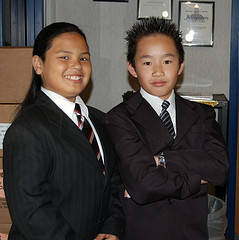Finally, Consultants to Schools Who Actually Know What They Are Talking About

It’s simply not possible.
Or is it?
Let’s say you’re a middle school principal. How can you engage a large group of consultants, each having anywhere between six to eight years of classroom experience, and have them conduct 90 days of observation between the beginning of the school year and November wherein they generate insights on improving curriculum, culture, and student morale? By the way, they won’t charge your school district a dime. And the solutions they provide will be exactly what your school needs.
Do you write a grant to some well-intentioned reform-minded foundation?
Nope.
Do you cajole some pro-bono work out of a prestigious consulting group?
Not quite.
Did I mention that the consultants are between 12 and 14 years old?
That’s because they’re your own students. The students in schools represent a crack consulting team just waiting to be tapped into. By their very nature they’re observing, interacting, and working with teachers, staff and other students every day. All that’s left for principals and teachers to do is extract the students’ “consultant report,” which is obtained by merely tuning in — tuning in to the students’ voice, that is. By asking students questions about their experiences, needs and desires, educators can gain greater understanding about what’s important to students, leading to imaginative solutions on issues schools are facing.
In the book The Third Teacher: 79 Ways You Can Use Design to Transform Teaching & Learning, item 71 on the list is “Consult with Kids. Survey students about what they would like to study, then design spaces that let them learn what they want to learn” (p. 225). As Bruce Mau notes, “This is actually a pretty radical idea: to open source school, to say ‘well, maybe the best source of information on this practice is the participants themselves.’ We assume they don’t know anything, and I think that’s the biggest mistake we make” (p. 225).
As they say at the Stanford dSchool, “good design is grounded in a deep understanding of the person for whom you are designing.”
If you want to solve a problem that has anything to do with the students in your school, ask some students what they’d do. You’ll be surprised and delighted by the insights they offer.
[Image credit: Flickr user daveparker]





